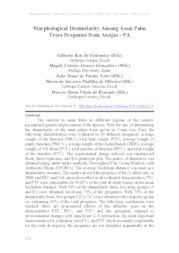Morphological dissimilarity among assai palm trees progenies from Anajás - PA.
Morphological dissimilarity among assai palm trees progenies from Anajás - PA.
Author(s): YOKOMIZO, G. K. I.; GONÇALVES, M. C. A.; FARIAS NETO, J. T. de; OLIVEIRA, M. do S. P. de; RESENDE, M. D. V. de
Summary: The interest in assai fruits in different regions of the country necessitates genetic improvement of the species. With the aim of determining the dissimilarity of the assai palms trees grown in Tomé-Açu, Pará, the following characteristics were evaluated in 30 different progenies: average weight of the bunches (PMC), total fruit weight (PTF), average weight of empty bunches (PMCV), average length of the rachis/bunch (TMR), average weight of 100 fruits (PCF), total number of bunches (NTC), and total weight of the bunches (PTC). The experimental design utilized was randomized block, three replicates, and five plants per plot. The matrix of dispersion was obtained using multivariate methods, Unweighted Pair Group Method, with Arithmetic Mean (UPGMA). The average Euclidean distance was used as a dissimilarity measure. The results showed the presence of theG effect only in TMR and NTC and GxE interaction effect in all evaluated characteristics. PTC and PTF were responsible for 99.85% of the total diversity based on the mean Euclidean distance. With 50% of the dissimilarity limit, two large groups (A and B) were obtained, involving 70% of the progenies. With 70% of the dissimilarity limit, five groups ("a" to "e") were obtained with a majority group (a) containing 80% of the total progenies. The following conclusions were reached: there are pronounced effects of the different years on the characteristics PTF, NTC, and PTC and the progenies respond to environmental changes with significant G×E interaction; the most important characteristics for evaluation were PTC and PTF which are mainly responsible for the total divergence; the progenies are not classified sequentially in the dendrogramand there are divergences between access fromclose provenances for performing crosses.
Publication year: 2019
Types of publication: Journal article
Unit: Embrapa Amapá
Observation
Some of Embrapa's publications are published as ePub files. To read them, use or download one of the following free software options to your computer or mobile device. Android: Google Play Books; IOS: iBooks; Windows and Linux: Calibre.
Access other publications
Access the Agricultural Research Database (BDPA) to consult Embrapa's full library collection and records.
Visit Embrapa Bookstore to purchase books and other publications sold by Embrapa.

